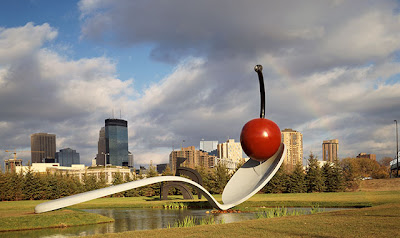Art, food for the soul... (Part II)
4:24 p.m.
A particular case of art with food is that of Victor Grippo (Buenos Aires, 1936-2002), a conceptual artist who worked with potatoes.
Analogía I, by Victor Grippo (1970-1971)
Technique: wood, electric circuit, cables, electrodes and potatoes
Measures: 64 x 90 x 46 cm -
Museo Nacional de Bellas Artes - Buenos Aires.
Technique: wood, electric circuit, cables, electrodes and potatoes
Measures: 64 x 90 x 46 cm -
Museo Nacional de Bellas Artes - Buenos Aires.
Victor Grippo studied chemistry at the Universidad de la Plata and took clases at the Escuela Superior de Bellas Artes. In 1970 he began his series of Analogías, in which he used organic materials, like the potatoes shown on the artwork at the MNBA. In this case, what's important it's the idea, the concept. They are not constructions to just see, but mainly to think about, to stimulate new ideas through a context that it's as important as the artwork itself.
In this case, Grippo builds a "potato battery" which produces energy when the circuit is closed through a switch. The potato, native from the Andes, was the main food of the Incas and, taken to Europe by the Spanish, soon became the food of the poor. It can be related to Latin America's origin and colonisation.
Grippo wants to show that many potatoes can generate the energy a single potato could not. Thus, our individual conscience can expand if we connect to others, transforming our potential. In other words, the installation symbolises the energy of the American continent.
The work is made of 40 potatoes which are changed every 20 days, by Museum personnel. It's not important who changes the potatoes, but the idea behind the artworks.
Now let's see other pieces at Claes Oldenburg's exhibition, "The Street and the Store," at the MoMA in Nueva York, and some of his large-scale constructions in open air.
Pastry Case I, by Claes Oldenburg (1961-1961)
Measures: 52.7 x 76.5 x 37.3 cm
Museum of Modern Art - New York
Above, shelves with all kinds of deserts, made in painted cardboard and placed on porcelain plates or stainless steel cups.
Floor Cake, by Claes Oldenburg (1962)
Materials: fabric, acrylic paint, sponge and cardboard.
A one-mt-super-cake on the floor. As the photo shows, it is soft and fluffy. Oldenburg does this work, as that of the hamburger, in the 60s. By then, using a soft structure in an artistic construction was an innovation and also a controversy.
Bacon and Egg, by Claes Oldenburg (1965)
Museum of Modern Art - Nueva York
The typical american breakfast, eggs and bacon, presented as a canvas... The piece belongs to a private collector and was lent specially for the exhibition.
And now, two examples of outdoor "food art"...
Spoonbridge and cherry, de Claes Oldenburg & Coosje van Bruggen (1988)
Materials: stainless steel with enamel / Measures: 9 x 15.7 x 4.1 mts
Walker Art Center - Minneapolis, Minnesota.
In this case, a monumental work in a square of Minneapolis, where a spoon holding a cherry acts like a bridge to cross the lagoon. In this type of large scale constructions, Oldenburg worked together with his wife, Coosje van Bruggen (Netherland, 1942 – Los Angeles, 2009), who was a sculptor, historian and art critic.
Finally, below, the famous ice-cream which has "fallen" on the rooftop of a building that houses an art gallery in Germany...
Dropped Cone, by Claes Oldenburg (2001)
Materiales: stainless steel, plastic fibers, wood, acrylic paint / Measures: 12.1 mts. tall x 5.5 mts. diameter.
Neumarkt Galerie - Cologne, Germany.















0 comentarios